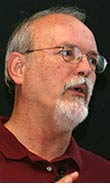Conventional, energy-efficient residences compared in study

John Bryant
The difference in energy consumption between two homes in Qatar — one built to a strict energy efficiency standard and the other using conventional construction — is being measured by a team of researchers at Texas A&M led by John Bryant, an associate professor of construction science who also serves on the mechanical engineering faculty at Texas A&M University at Qatar.
The study is part of a Qatari initiative to form a “greener” future for the Persian Gulf nation.
“Sustaining economic growth is not possible without having a vision that creates the balance needed between economic development and protection of the environment,” said Ahmad Al-Abdulla, deputy group chief executive officer at Barwa Real Estate in Qatar. “Despite recent forecasts, which claim that Qatar can fulfill its energy needs for many years to come, various organizations across the country have already launched initiatives to promote the concept of energy saving.“
Bryant’s study will measure the energy use of two 740-square-foot residences, one built using Passivhaus specifications, developed by two researchers in Germany in the 1990s, resulting in a building that requires little energy for cooling or heating.
Energy use in a Passivhaus is minimized through a number of methods, including very high levels of insulation, airtight construction, solar panels, small windows, high-efficiency air conditioning and passive lighting schemes such as skylights.
The other residence, built adjacent to the Passivhaus, will be built using standard construction techniques.
The homes are undergoing a six-month period of testing and observation to compare their baseline performance without occupants; families are scheduled to move into the residences this fall, when Bryant will make further observations for one year.
His study is part of a 2-year, $665,000 project, underwritten by the Qatar National Research Fund, in which he’s also investigating the potential and actual energy use in the Texas A&M University at Qatar building and the 58-story RasGas Tower, headquarters of a Qatar natural gas company.
Bryant will use energy modeling software to determine the buildings’ energy use potential and install meters to measure their actual energy consumption.
“In cases where it is clear there are significant differences, we will gather data to evaluate building maintenance and operation behaviors,” he said.
Bryant’s collaborators in the study are co-principal investigators Zofia Rybkowski, assistant professor of construction science, Mardelle Shepley, professor of architecture and Alex Amato, head of sustainability of Qatar’s Green Building Council.
Tags
- coa gallery
- construction science
- cosc gallery
- energy
- energy sustainability
- environment
- feature
- global college
- partnerships
- research
- rss
- sustainability
Related Posts

Light pipe tests under way at daylighting lab

Survey: Undersized IT budgets stifling building industry

Oct. 23 symposium spotlighted college, faculty research

Research, creative work presented at annual symposium
Follow Us
Facebook Twitter Vimeo Youtube Flickr RSS
Recent Posts

Planning prof heads study of disaster housing aid

A message from the dean

Former student remembered as expert planner

Leading educator named new head of Architecture Dept.







_thumbnail_small.png)
